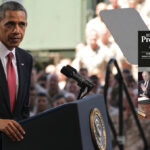
What is readiness? The state of being fully prepared for something? But what is that something? And what does fully prepared mean or more importantly cost? The military has used readiness as a metric of success for years driving budgets and training and acquisition efforts across the force. A BETTER PEACE welcomes our own Tom Galvin to discuss the War College’s latest look at readiness. He joins podcast editor Ron Granieri in the virtual studio to discuss what he has termed enterprise readiness. The topic spans ideas such as intellectual readiness, strategic agility, large scale warfare and the role of national readiness and nesting into the the country’s strategic communications.
How do we as a defense enterprise, also get the nation ready? How do we plug into the national capability in the event that we have to go back to the big wars when we had to nationalize industry, when we had to nationalize other assets, when we had to draw from the populace far more than what the all volunteer force currently currently provides?
Podcast: Download
The publications referenced in this episode can be found here in the Practitioner’s Corner.
Tom Galvin is Associate Professor of Resource Management in the Department of Command Leadership and Management as well as the leadership and management instructor for the Carlisle Scholars Program. at the United States Army War College. He is the author of the monograph Leading Change in Military Organizations and companion Experiential Activity Book.
Ron Granieri is an Associate Professor of History at the U.S. Army War College and the Editor of A BETTER PEACE.
The views expressed in this presentation are those of the speakers and do not necessarily reflect those of the U.S. Army War College, U.S. Army, or Department of Defense.
Photo Description: Stoplights – the universal symbol for readiness reporting.
Photo Credit: Design vector created by macrovector – www.freepik.com





Phenomenal podcast. Hats off the the USAWC team. My question is how are we measuring “Enterprise Readiness”?
If we come to consider that the position of the U.S./the West — in the New/Reverse Cold War of today — that this is much the same as the position of the Soviets/the communists — in the Old Cold War of yesterday — then, I believe, we may have a good starting place with which to consider such things as “Enterprise Readiness: Preparing for Crisis.”
Explanation:
In the Old Cold War of yesterday (1946-1990), the Soviets/the communists were — both at home and abroad — in “revolutionary” mode; herein, hoping to achieve and/or maintain the political, economic, social and/or value changes needed to promote communism. This such posture placed the Soviets/the communists, back then, both in their home countries and abroad, (a) in opposition to the status quo and (b) in opposition to the conservative governments and population groups — both in their home countries and indeed throughout the world — who would stand and fight to defend the status quo (or to achieve a status quo anti; this, if too much unwanted change was thought to have already taken place).
In the New/Reverse Cold War of today (1991 to present), the U.S./the West has been — both here at home and there abroad — in “revolutionary” mode; herein, hoping to achieve and/or maintain the political, economic, social and/or value changes needed to promote such things as capitalism, globalization and the global economy. This has placed the U.S./the West, today, both here in our own home countries and there abroad (a) in opposition to the status quo and (b) in opposition to the conservative governments and population groups — both in our own home countries and indeed throughout the world — who would stand and fight to defend the status quo (or to achieve a status quo anti; this, if too much unwanted change was thought to have already taken place).
(Should you wish to disagree with this comparison, then please consider the information that I have provided at the very recent War Room Blog threads “LEADERSHIP 2040: A PATHWAY TO THE FUTURE EPs 1 – 3.”)
Based on the comparison I make above, the appropriate questions seem to become:
a. How did the Soviets/the communists — during the Old Cold War when they were in “revolutionary” mode back then — successfully do “Enterprise Readiness: Preparing for Crisis?” And:
b. Given that the U.S./the West is in “revolutionary” mode in the New/Reverse Cold War of today, is there is there anything that the U.S./the West can learn from and/or use; this re: how the Soviets/the communists, in the Old Cold War of yesterday, did “Enterprise Readiness: Preparing for Crises” back then?
If we come to consider that the position of the U.S./the West — in the New/Reverse Cold War of today — that this is much the same as the position of the Soviets/the communists — in the Old Cold War of yesterday — then, I believe, we may have a good starting place with which to consider such things as “Enterprise Readiness: Preparing for Crisis.”
Explanation:
In the Old Cold War of yesterday (1946-1990), the Soviets/the communists were — both at home and abroad — in “revolutionary” mode; herein, hoping to achieve and/or maintain the political, economic, social and/or value changes needed to promote communism. This such posture placed the Soviets/the communists, back then, both in their home countries and abroad, (a) in opposition to the status quo and (b) in opposition to the conservative governments and population groups — both in their home countries and indeed throughout the world — who would stand and fight to defend the status quo (or to achieve a status quo anti; this, if too much unwanted change was thought to have already taken place).
In the New/Reverse Cold War of today (1991 to present), the U.S./the West has been — both here at home and there abroad — in “revolutionary” mode; herein, hoping to achieve and/or maintain the political, economic, social and/or value changes needed to promote such things as capitalism, globalization and the global economy. This has placed the U.S./the West, today, both here in our own home countries and there abroad (a) in opposition to the status quo and (b) in opposition to the conservative governments and population groups — both in our own home countries and indeed throughout the world — who would stand and fight to defend the status quo (or to achieve a status quo anti; this, if too much unwanted change was thought to have already taken place).
(Should you wish to disagree with this comparison, then please consider the information that I have provided at the very recent War Room Blog threads “LEADERSHIP 2040: A PATHWAY TO THE FUTURE EPs 1 – 3.”)
Based on the comparison I make above, the appropriate questions seem to become:
a. How did the Soviets/the communists — during the Old Cold War when they were in “revolutionary” mode back then — successfully do “Enterprise Readiness: Preparing for Crisis?” And:
b. Given that the U.S./the West is in “revolutionary” mode in the New/Reverse Cold War of today, is there is there anything that the U.S./the West can learn from and/or use; this re: how the Soviets/the communists, in the Old Cold War of yesterday, did “Enterprise Readiness: Preparing for Crises” back then?
So let me attempt to answer the question below (from the introduction page to our podcast above); this, from perspective of the “revolutionary”/”change is required to survive” challenges that we are said to face today. First, the question:
“How do we as a defense enterprise, also get the nation ready? How do we plug into the national capability in the event that we have to go back to the big wars when we had to nationalize industry, when we had to nationalize other assets, when we had to draw from the populace far more than what the all volunteer force currently provides?”
Next, a discussion of the “revolutionary”/”change is required to survive” challenges that we face today:
“We agree with Bobbitt that a global transition from Nation States to Market States is now well underway. The chief thesis of this Article is that the Supreme Court has embarked on a program of reshaping constitutional doctrine so as to encourage and facilitate the emergence of a fully developed Market State in this polity, with a view to positioning the United States to be successful in meeting the competitive challenges of a new, post Cold War international order. In taking this course, the Court has increasingly aligned itself with the prescriptive views of American business and political elites, for whom globalization is understood ‘not merely [as] a diagnostic tool but also [as] an action program.’ From this perspective, globalization ‘represents a great virtue, the transcendence of the traditional restrictions on worldwide economic activity .., inherent in the era of Nation States.’ Proponents of this vision of a globalized economy characterize the United States as ‘a giant corporation locked in a fierce competitive struggle with other nations for economic survival,’ so that ‘the central task of the federal government’ is ‘to increase the international competitiveness of the American economy.’ ”
(See the Catholic University of America, Columbus School of Law paper “Moral Communities or a Market State: The Supreme Court’s Vision of the Police Power in the Age of Globalization by Antonio F. Perez and Robert J. Delahunty; therein, see Page 643.)
The problem here, of course, is that (a) in order “to increase the international competitiveness of the American economy” (and, thereby, survive), we must (b) first introduce and see through political, economic, social and/or value changes that conservative governments and population groups often have great trouble accepting. As to the reason why this is so, see the last sentence in the quoted paragraph below:
“Capitalism is the most successful wealth-creating economic system that the world has ever known; no other system, as the distinguished economist Joseph Schumpeter pointed out, has benefited ‘the common people’ as much. Capitalism, he observed, creates wealth through advancing continuously to every higher levels of productivity and technological sophistication; this process requires that the ‘old’ be destroyed before the ‘new’ can take over. … This process of ‘creative destruction,’ to use Schumpeter’s term, produces many winners but also many losers, at least in the short term, and poses a serious threat to traditional social values, beliefs, and institutions.”
(From the book “The Challenge of the Global Capitalism: The World Economy in the 21st Century,” by Robert Gilpin, see the Introduction.)
Back to the original question now: “How do we as a defense enterprise, also get the nation ready?”
Possible answer: By providing the American people with the “what is required and why” information that I have outlined above.
Herein, defining the “big war,” thus, more in “international economic competitiveness” (requires necessary political, economic, social and/or value “changes” to prevail) rather than in military terms.